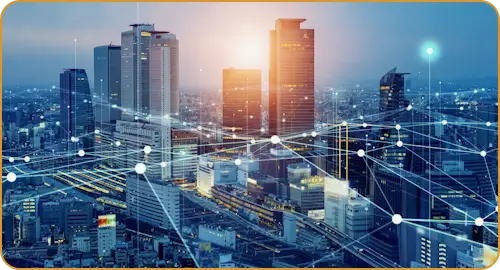Technology
The myth of the cloud as a technology paradise
In the past, ERP technology was about stable, on-premises servers and software you could control. Today, it’s a dynamic, cloud platform that must be agile, intelligent, and secure to support growth and innovation. The advantages are clear, the hazards are less obvious.
Choosing the right technology isn’t a technical decision, it’s a business decision that will define your organization’s flexibility and competitive edge for the next decade or more.

Getting the right things right

A modern ERP platform is a complex ecosystem of software, infrastructure, and services.
You make major decisions when you choose the system and your implementation partner. With those exceptions, more than any other pillar, technology is about making the right major decisions – getting the architecture right.
To get it right, you need to consider new challenges, including the architecture, security, integration, mobile access, extensibility, and fundamental changes the shift to the cloud will mean for your IT department.
Navigating Technology
The Cloud: A Clear-Eyed Look at Promise and Reality
On-Prem vs Cloud - Control vs Convenience
Challenge
The on-premise vs cloud hosting decision is one of the most important decisions in the implementation of an ERP system, and possibly in the life of your business.
Trade-Off
This is a business decision between two competing ideas: total Control with On-Premise or significant Convenience with Cloud. Complicating the decision is the uncertainty of AI, and the uncertainty of cost.
Impact
The decision will directly affect your company’s financial structure, operational flexibility, security, and ability to innovate in the future.
On-Premises

On-prem is like traveling by car. You control the destination, but you have to drive.
Model
On-premise is the choice for full control. You buy, own, and manage all hardware, software, and data within your facilities.
Upside
You get unmatched customization for specific processes. You also have complete authority over data privacy, security, and update schedules.
Downside
There is a high upfront cost for equipment and software. You take on the ongoing responsibility for maintenance, security, and IT staffing. On-prem is rigid, which makes scalability slow and costly.
The Cloud

The cloud is like traveling by train. You’re going wherever the train is going, and it’s easy.
Model
Cloud ERP (SaaS) operates like a utility. You pay a subscription fee regularly. The vendor owns and manages the platform.
Upside
You gain financial flexibility with no hefty upfront costs. Deployment is quick, and scaling up or down can happen almost instantly. The vendor handles security, maintenance, and provides ongoing innovation.. You’re on board with where the ERP vendor takes you regarding AI.
Downside
You lose direct control. You could face significant “vendor lock-in,” making it tough to switch providers. Your operations depend entirely on access to the internet.
The On-Prem AI Risk
AI is changing ERPs from systems that track past events to those that provide insights into future possibilities, including predictive forecasting and Generative AI tools.
Developing AI requires vast computing resources and large datasets. Cloud vendors are investing heavily to provide AI as a built-in, continually updated service.
The On-Premise Risk: On-premise systems miss out on this innovation. They lack the necessary scale, data, and computing power, creating a growing “innovation gap.” They risk becoming obsolete data repositories.
Total Cost of Ownership (TCO):
Challenge
Comparing a one-time license fee with a monthly subscription is misleading. A proper TCO analysis must consider all hidden costs over a 5- to 10-year period.
On-Premise
High upfront expenses (hardware, licenses) PLUS high ongoing operational costs (IT staff salaries, annual maintenance fees, hardware replacement cycles, energy costs).
Hidden expenses include ongoing operational costs, such as large software maintenance fees, salaries for IT staff, frequent hardware replacements, and facility costs for power and cooling.
Cloud
An ongoing subscription fee.
This fee can be considered an expense that enables scaling and innovation without necessitating a new round of spending.
Once you are committed to the cloud model and vendor, you are ‘locked-in’ to that combination, with significant cost involved in changing. Should the subscription price structure change (go up), you may have few choices.
Security: Protecting Your Enterprise
Shared Responsibility
Challenge
Moving to the cloud doesn’t mean passing off security. It means security is shared.
Impact
A “Responsibility Gap” results in security gaps that can cause data breaches.
Solution
Clearly understand what your provider secures (“Security of the Cloud”) versus what you must secure (“Security in the Cloud”).
Provider: Security OF the Cloud
When you switch to a cloud platform, you should gain access to a top-notch security setup. The Cloud Service Provider (CSP) is responsible for protecting the hardware that supports its services.
This encompasses the physical security of data centers, core networking, and the virtualization layer. You relieve yourself of the huge burden of managing and securing physical infrastructure.
Your Responsibility: Security IN the Cloud
You, the customer, are fully responsible for securing everything you create, configure, and store within that cloud environment. This includes your data, its classification, your applications, and most importantly, your identity and access controls.
The biggest risk in a cloud ERP often comes from failing to properly implement your side of the model. These easily avoidable mistakes are the main vulnerability.
The Zero Trust Mandate: Never Trust, Always Verify
Challenge
The old “castle-and-moat” security model is outdated. The perimeter is gone, and resources are spread across clouds and remote devices.
Impact
A perimeter-based model that views the internal network as a “trusted zone” creates a significant vulnerability. Once an attacker gains entry, they can move freely
Solution
Adopt a Zero Trust philosophy: “Never trust, always verify.” This model assumes a breach is likely and continuously checks risk for each access request.
Zero Trust Architecture (ZTA) is not a product; it’s an approach. It starts with the idea that no user, device, or network is automatically trustworthy, no matter where it is located. A breach is always possible.
Proactive Governance, Risk, and Compliance (GRC)
Challenge
Treating GRC as an afterthought, a final “checkbox” to be checked just before launching. This method is reactive, expensive, and inefficient.
Impact
This leads to manual workarounds, data integrity risks, and costly compliance issues after the system goes live.
Solution
Incorporate GRC into the design of the ERP from the start. This approach makes compliance a proactive way of doing business instead of a reactive cost.
Your ERP Is Not an Island: The Integration Challenge
Not an Island
A modern cloud ERP should be a System of Record (SoR) for core financial and operational transactions. However, it typically does not provide a single source of truth for the entire business.
In today’s best-of-breed environment, organizations maintain multiple Systems of Record. For example, a CRM stores customer data, a payroll system handles HR, and an ERP keeps operational and financial records. Architecturally, a cloud ERP functions as a black box. Direct database access is replaced by a controlled API layer
Point-to-Point Integration
Traditionally, organizations connected these systems by building direct, custom-coded, point-to-point (P2P) links whenever integration was required. This approach does not scale. At some point, it becomes an unmanageable web of integrations.
- Brittle and Fragile: A change in one application, like a vendor update, can trigger failures in other systems.
- High Risk: It creates a dependency on a small group of developers who are familiar with the custom code. Maintenance becomes a bottleneck.
- Ungovernable: Without central management, this integration tangle cannot be effectively secured, managed, or scaled.
Integration Platform as a Service (iPaaS)
A modern solution replaces this fragile integration with cloud platform-based approach. This strategy relies on two complementary structures:
Integration Platform as a Service (iPaaS)
This is a centralized, cloud-based hub. It uses pre-built connectors and low-code tools to build, deploy, and manage all integrations in one place. It simplifies development and provides a single dashboard to monitor the integration landscape.
API Connectivity
This provides the architectural blueprint for building integrations. Instead of simple P2P links, it organizes integrations into three reusable layers:
- System APIs: Securely unlocks data from your core Systems of Record
- Process APIs: Combines and orchestrates data from multiple System APIs into business processes
- Experience APIs: Deliver process data to end-users in a clear format, such as through a mobile app or partner portal.
Approach Comparison
Feature
Point-to-Point
iPaaS
Architecture
Decentralized
Centralized / Composable
Scalability
Low (complexity increases exponentially)
High (Elastic & Reusable)
Agility (Speed)
Low (Custom Code)
High (Low-Code & Reusability)
Maintenance
High
Low (Managed Platform)
Best For
Simple, few systems
Dynamic, hybrid/cloud-first environments
The Ecosystem of the Platform
The Core Foundation
Challenge
Traditional, on-prem ERPs are rigid, and customization creates technical debt, making upgrades costly and risky.
Impact
This business processes are ‘locked in,’ stifling innovation with a system that blocks change instead of supporting it.
Solution
A “Clean Core” strategy. The ERP acts as a standard digital foundation, and the stability at the center allows for flexibility at the edges.
The Extension Layer
Challenge
Traditional, on-prem ERPs are rigid, and customization creates technical debt, making upgrades costly and risky.
Impact
This business processes are ‘locked in,’ stifling innovation with a system that blocks change instead of supporting it.
Solution
A “Clean Core” strategy. The ERP acts as a standard digital foundation, and the stability at the center allows for flexibility at the edges.
The Human Layer: Expertise
Challenge
Technology is only part of the equation. Most ERP projects fail due to human factors, including the application of scarce expertise.
Impact
The expected ROI is never achieved because people were overlooked.
Solution
A mature “Human Layer.” A strong ecosystem offers a global network of certified implementation partners, expert consultants, and active user communities to reduce investment risks.
The Strategic Value: Agility, Innovation, and TCO
Challenge
A traditional ERP is a depreciating asset. It is a significant cost center that locks in capital and hinders change.
Impact
The business becomes slow and inefficient. It struggles to adapt to market threats or opportunities. The total cost of ownership (TCO) increases due to technical debt.
Solution
The ecosystem model delivers growing returns. It lowers TCO by shifting to a subscription model. It improves agility, allows responses in weeks instead of years, and accelerates innovation (like AI). It transforms the ERP into a strategic asset.
Ecosystem Health: A Framework for Success
Challenge
Not all ecosystems are the same. This model introduces new, complex risks like vendor lock-in, third-party security gaps, and integration difficulties.
Impact
A poorly chosen ecosystem can be worse than a monolith. It can lead to data breaches, system instability, and a significant loss of strategic control.
Solution
A formal governance framework to assess and manage the ecosystem. Evaluate API openness, marketplace quality, and the health of the partner network to reduce risks.
Rethinking Your IT Department for the Cloud Era
From Infrastructure Engineers to Service Brokers
Challenge
The need for infrastructure engineers is greatly diminished in a cloud-based enterprise.
Impact
The role of IT changes.
Solution
IT evolves from building assets to being a “broker of services.” The focus is on coordinating a range of cloud vendors and providing the business with a secure service catalog.
From Control to Orchestration
A cloud enterprise transfers responsibilities from the organization to the vendor. This means the focus moves from managing physical assets to ensuring reliable delivery of services.
The New Role: Strategic Service Broker
The IT department needs to evolve. Building on this, its role should be to understand strategic needs and then source, integrate, and manage a portfolio of cloud services that meet these needs. IT changes from builders and maintainers to coordinators and facilitators.
The ‘Enablement’ Transition
In a multi-vendor cloud environment, the IT department shifts to an enablement role. It provides a curated and secure “service catalog” of cloud solutions. This approach enables the business to follow a compliant and secure path.
This shift also raises vendor management from a procurement task to a strategic skill. The vendor becomes an operational partner, and managing that relationship is as important as managing internal servers once was.
Potential Evolution of Roles
Traditional Role
Cloud Evolution
Cloud Responsibilities
System Administrator
Cloud / Site Reliability Engineer (SRE)
Automating infrastructure provisioning (IaC), ensuring system reliability through code.
Network Engineer
Cloud Network Specialist
Designing virtual private clouds (VPCs) and software-defined networking (SDN)..
Database Administrator
Data Engineer / Cloud DBA
Managing scalable cloud database services and building data pipelines.
Business Analyst
Product Manager (for IT Services))
Defining and managing internal IT services as “products” focused on value delivery.
The Taxonomy of Technology Success
Getting Technology right requires getting a hierarchy of things right. Explore the taxonomy of Technology critical success factors below. Click the grey + to reveal more detail.
- Technology
- Architecture
- Philosophy & Strategy
- Scalable, Flexible Architecture
- Composable & Modular Design
- System Selection & Configuration
- System Selection
- Governance of Configuration vs. Customization
- Platform & Infrastructure
- Deployment Model & Hosting Strategy
- Cloud-Centric Strategy (Cloud-First, Hybrid)
- On-Premise and Legacy
- Core Infrastructure
- Hardware and Environment Planning
- Database Strategy
- Integration & Interoperability
- Integration Strategy
- Integration Planning
- Ownership of Integration
- Integration Architecture
- Decoupled Integration
- API-First Principles
- Integration Platform